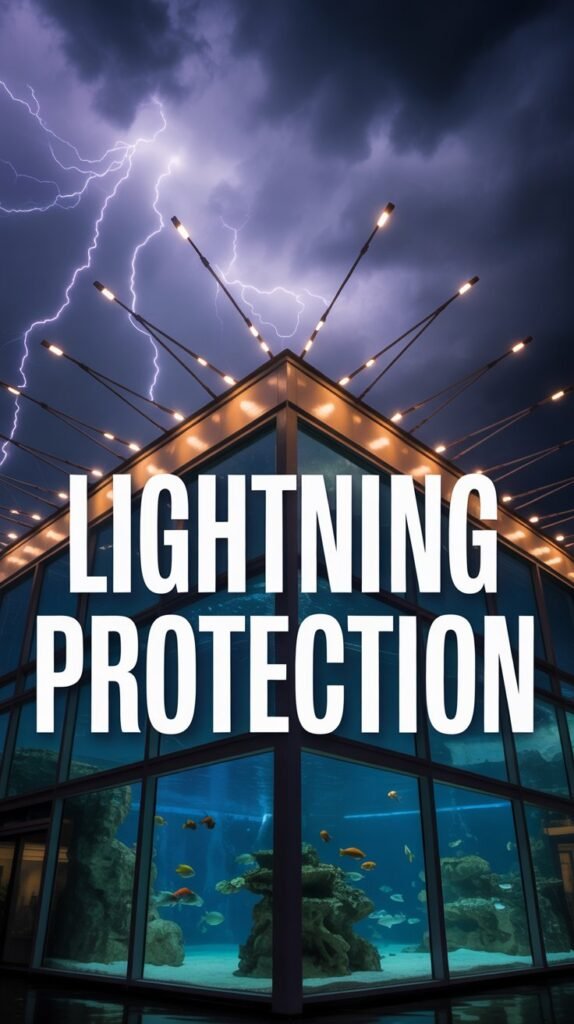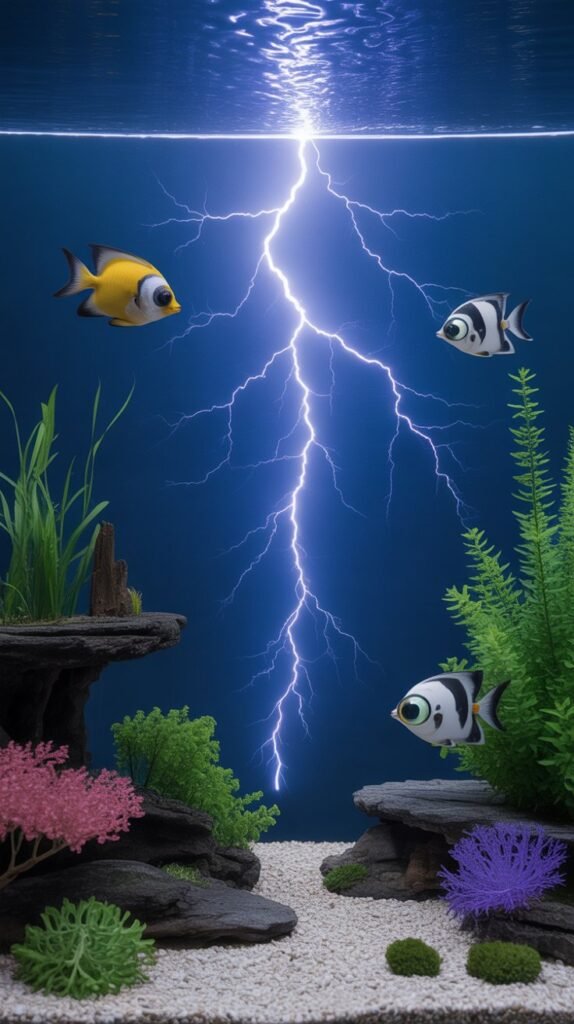Aquarium keeping is a rewarding hobby, but it also involves managing electrical equipment such as filters, heaters, lights, air pumps, and controllers. While most aquarists focus on water quality, tank maintenance, and fish health, one important yet often overlooked aspect is lightning protection for aquariums.
In many regions, thunderstorms are frequent, and lightning strikes can cause dangerous power surges, voltage spikes, and electrical outages. These sudden electrical disturbances can damage your aquarium equipment instantly—or worse, pose risks to your fish and your home.
This in-depth guide explores everything you need to know about lightning protection for aquariums, including how lightning affects aquarium electronics, the best safety devices, surge protection methods, grounding, and emergency plans for fishkeepers.
What Is Lightning Protection for Aquariums?
Lightning protection for aquariums refers to a combination of devices and practices designed to shield aquarium equipment from electrical hazards caused by lightning storms. These include:
- Voltage surge protection
- Power outage backup systems
- Circuit breakers and GFCI outlets
- Grounding and bonding
- Safe electrical layout
- Preventing shock hazards
- Protecting heaters, filters, air pumps, lights, and controllers
Proper lightning protection ensures that the tank continues running safely even during extreme weather conditions and that both your fish and your home remain safe.
Why Lightning Protection Matters for Aquariums

Many aquarists underestimate the number of electrical devices their tanks rely on. A typical setup includes:
- Aquarium light
- Water heater
- Filter (HOB, canister, or sponge)
- Air pump
- Wave makers
- CO₂ systems
- Monitoring and automation systems
When lightning strikes, even indirectly, it can cause:
1. Electrical Surges
A surge is a sudden spike in voltage—often thousands of volts—that travels through power lines. Aquarium devices are sensitive, and even a small surge can fry:
- Heaters
- LED lights
- Filters
- Timers and controllers
A large surge can damage all devices at once.
2. Power Outages
Storms may knock out electricity for minutes or hours. Without power:
- Filters stop working → ammonia rises
- Heaters turn off → temperature drops
- Air pumps stop → oxygen levels fall
In sensitive tanks (shrimp, discus, marine fish), short outages can be fatal.
3. Electrical Shock Hazards
Faulty or damaged aquarium equipment can leak voltage into the water. Lightning-induced surges increase the risk of:
- Shock to the aquarist
- Stress or death of fish
- Fire hazards
4. Equipment Failure and Expensive Losses
Replacing damaged equipment can cost more than installing proper protection.
How Lightning Damages Aquarium Equipment
Lightning does not have to strike your house directly to cause damage. Most damage comes from:
- Nearby lightning strikes
- Sudden changes in voltage
- Overloaded power lines
- Transformer damage
The electricity travels through:
- Power sockets
- Extension boards
- UPS devices
- Internet routers (if monitors are connected)
Aquarium heaters are particularly vulnerable because they operate on thermostats, which are sensitive to voltage changes.
Essential Lightning Protection Devices for Aquariums

To effectively protect your aquarium from lightning and power disturbances, you must understand the essential devices that safeguard electrical systems.
1. Surge Protectors
A surge protector is the first line of defense. It absorbs or blocks excess voltage caused by lightning spikes.
Benefits of surge protectors for aquariums:
- Prevent equipment burnout
- Protect sensitive electronics
- Reduce fire risks
- Extend lifespan of filters and heaters
Choose one with:
- Joule rating at least 2000
- Overload protection
- Aquarium-safe certifications
Avoid cheap power strips—they do NOT offer surge protection.
2. GFCI (Ground Fault Circuit Interrupter)
A GFCI outlet is crucial for any aquarium. It cuts power instantly if it detects current leaking into water or metal equipment.
Why GFCI is essential:
- Prevents electrocution
- Protects aquarium devices
- Reduces fire hazard
- Stops damage from water spills
GFCI outlets should be installed wherever aquarium equipment plugs in.
3. Circuit Breakers
Circuit breakers provide overload protection by shutting off power when the electrical load becomes unsafe.
Why circuit breakers matter for lightning:
- Prevent system overload
- Reduce fire risk
- Protect aquarium devices from high current
A dedicated breaker for aquarium circuits is ideal.
4. Voltage Stabilizers or Line Conditioners
These devices ensure stable voltage even during fluctuations caused by storms.
Benefits:
- Keep heaters running safely
- Prevent LED flickering
- Protect pumps and filters from inconsistent voltage
These are especially valuable in areas with unstable electrical supply.
5. Uninterruptible Power Supply (UPS)
A UPS provides battery backup when the power goes out.
What a UPS does for an aquarium:
- Keeps filters running
- Maintains oxygen levels
- Runs air pumps for hours
- Prevents ammonia spikes
- Prevents temperature swings
For small tanks, even a small UPS can keep essential equipment running.
6. Aquarium Grounding Probe
A grounding probe safely channels stray voltage into the ground.
Why grounding probes help during storms:
- Protect fish from electrical shock
- Prevent voltage buildup
- Reduce aquarium stress symptoms
- Improve safety when handling tank water
Grounding is especially important for saltwater aquariums.
7. Waterproof Drip Loops
Simple but essential.
A drip loop prevents water from running into electrical outlets. This reduces the chance of short circuits during lightning storms when humidity and water splashes increase.
How to Protect Your Aquarium During Lightning Storms

Here are the best strategies to safeguard your aquarium.
1. Install a High-Quality Surge Protector
Use a heavy-duty, aquarium-rated protector. Never plug aquarium equipment directly into the wall.
2. Create Dedicated Electrical Lines
If possible, run your aquarium on a separate breaker. This prevents whole-house surges from hitting your system.
3. Use GFCI Outlets Near the Aquarium
This prevents shock hazards caused by lightning-induced voltage leaks.
4. Avoid Overloading Power Strips
Overloaded strips can burn during surges. Leave some space or use multiple strips.
5. Raise Power Strips Higher
Lightning storms can cause flooding or leaks. Keep electrical components above the water line and away from the floor6.
Install a Battery-Powered Air Pump
These automatically turn on during power outages, keeping oxygen levels stable.
7. Have a Backup Heating Plan
For cold climates, use:
- Insulating blankets
- Backup heaters
- UPS-supported heaters
Temperature drops can be deadly for tropical species.
8. Secure Lids and Cable Management
Proper cable organization reduces the chance of accidental shorts during humidity spikes caused by storms.
9. Use a Lightning Arrestor (Optional but Effective)
A lightning arrestor is a whole-house surge prevention device installed by an electrician. It protects everything—including your aquarium.
10. Disconnect Non-Essential Devices
During severe storms, turn off devices not needed for fish survival, such as:
- Lights
- CO₂ systems
Leave only life-support equipment on surge-protected power.
Species Most Sensitive to Lightning-Related Issues
Some aquarium inhabitants are more vulnerable to electrical disturbances.
Saltwater species:
- Clownfish
- Tangs
- Butterflyfish
- SPS corals
- Anemones
Freshwater species:
- Discus
- Shrimp
- Juvenile fry
- Bettas
These species require stable temperature and oxygen levels.
Lightning Protection for Saltwater vs. Freshwater Aquariums
Saltwater Aquariums
Saltwater tanks are more sensitive because:
- Salt conducts electricity
- Equipment is more advanced
- Reef tanks require high stability
Grounding probes and GFCI outlets are strongly recommended.
Freshwater Aquariums
Less prone to voltage buildup, but still at risk. For freshwater tanks:
- Surge protectors
- UPS
- Circuit breakers
- Drip loops
are essential.
Common Mistakes Aquarists Make During Storms
- Using cheap power strips
- Not installing GFCI outlets
- Running all equipment on one outlet
- No backup power source
- Using old or damaged equipment
- Ignoring smells or sparks
- Handling aquarium equipment with wet hands
Avoiding these mistakes improves safety significantly.
Building a Complete Lightning Protection Setup (Step-By-Step)
Step 1: Install a wall-mounted GFCI outlet
Step 2: Connect a surge protector to the outlet
Step 3: Connect aquarium devices to labeled sockets
Step 4: Add a grounding probe to the tank
Step 5: Install a UPS for the filter and air pump
Step 6: Use drip loops for all wires
Step 7: Keep cables elevated
Step 8: Regularly check equipment for damage
This setup ensures maximum safety during lightning activity.
Maintenance Tips for Lightning Protection Equipment
- Replace surge protectors every 2–3 years
- Test GFCI outlets monthly
- Ensure UPS batteries are healthy
- Inspect wires for cracks and moisture
- Replace old or buzzing appliances
- Keep electrical equipment dust-free
- Avoid rust-prone connectors
Proper maintenance ensures your lightning protection remains reliable.
FAQs About Lightning Protection for Aquariums
1. Can lightning directly harm my aquarium?
Not directly, but voltage surges and outages caused by lightning can damage equipment and harm fish.
2. Are surge protectors enough to protect my aquarium?
Surge protectors help, but a complete system includes GFCI outlets, UPS, grounding probes, and proper wiring.
3. What happens to fish if voltage leaks into the water?
Fish may show signs of stress, rapid breathing, erratic swimming, or even die if the shock is strong.
4. Should I unplug equipment during a storm?
If the storm is extremely severe and you’re home, unplug non-essential devices. Keep only filters and air pumps running—preferably through a UPS.
5. Do saltwater tanks need grounding more than freshwater tanks?
Yes. Saltwater is more conductive, increasing the risk of stray voltage.
6. How long can my aquarium survive a power outage?
Fish can survive 2–8 hours without filtration or heat depending on species. A UPS or battery air pump is strongly recommended.
7. Can power outages cause ammonia spikes?
Yes. Without filtration, beneficial bacteria stop processing waste, leading to rising ammonia levels.
8. Do I need a special electrician for lightning protection?
For installing GFCI outlets, dedicated breakers, or whole-house surge protection, a licensed electrician is recommended.
Final Thoughts
Lightning protection for aquariums is an essential yet underestimated part of responsible fishkeeping. Because aquariums rely heavily on electrical equipment, storms pose a real threat—not only to your devices but to your fish, your home, and your safety.
By using the right combination of surge protectors, GFCI outlets, grounding probes, UPS backup, and proper cable management, you can ensure your aquarium stays safe and stable during lightning storms.

